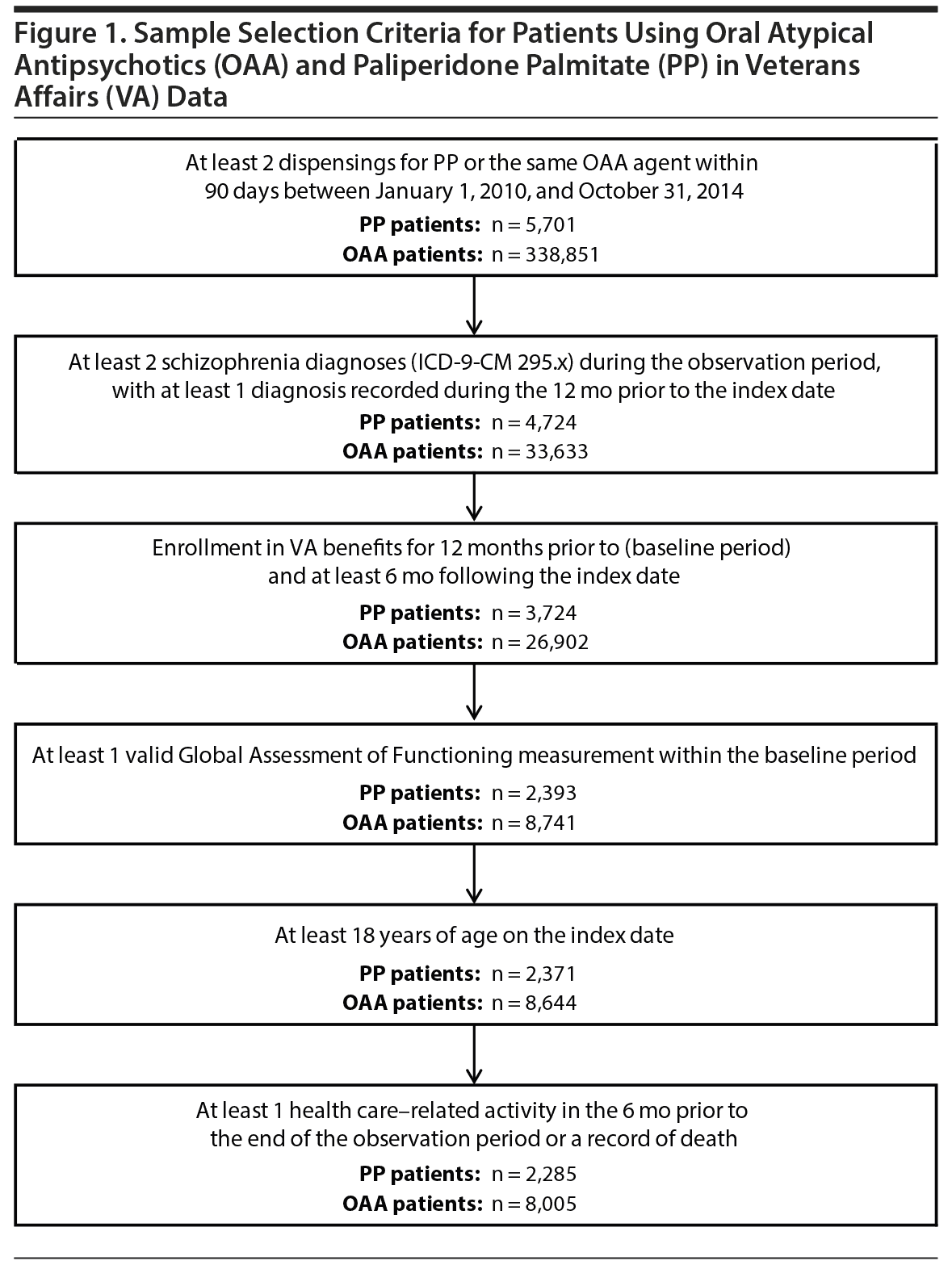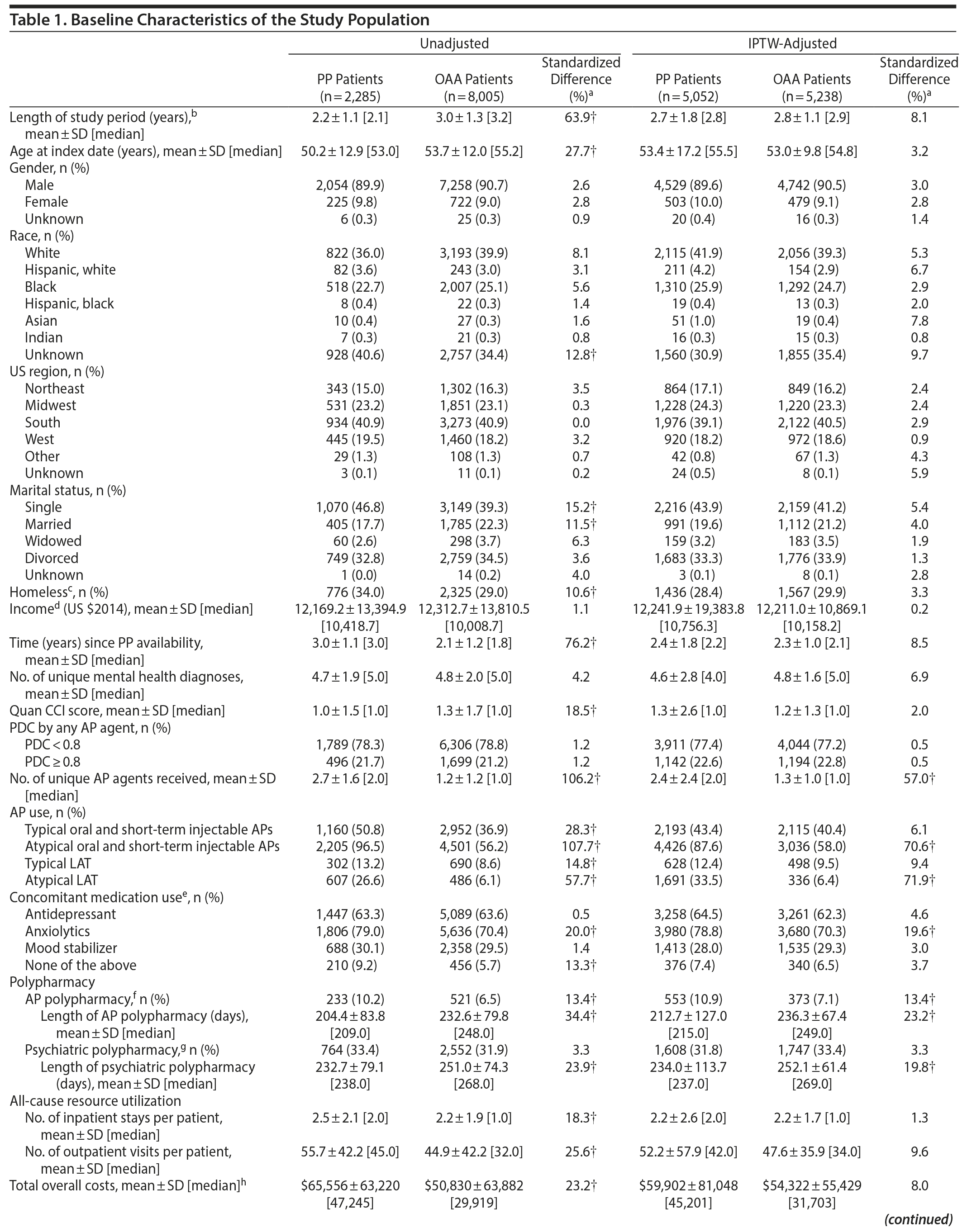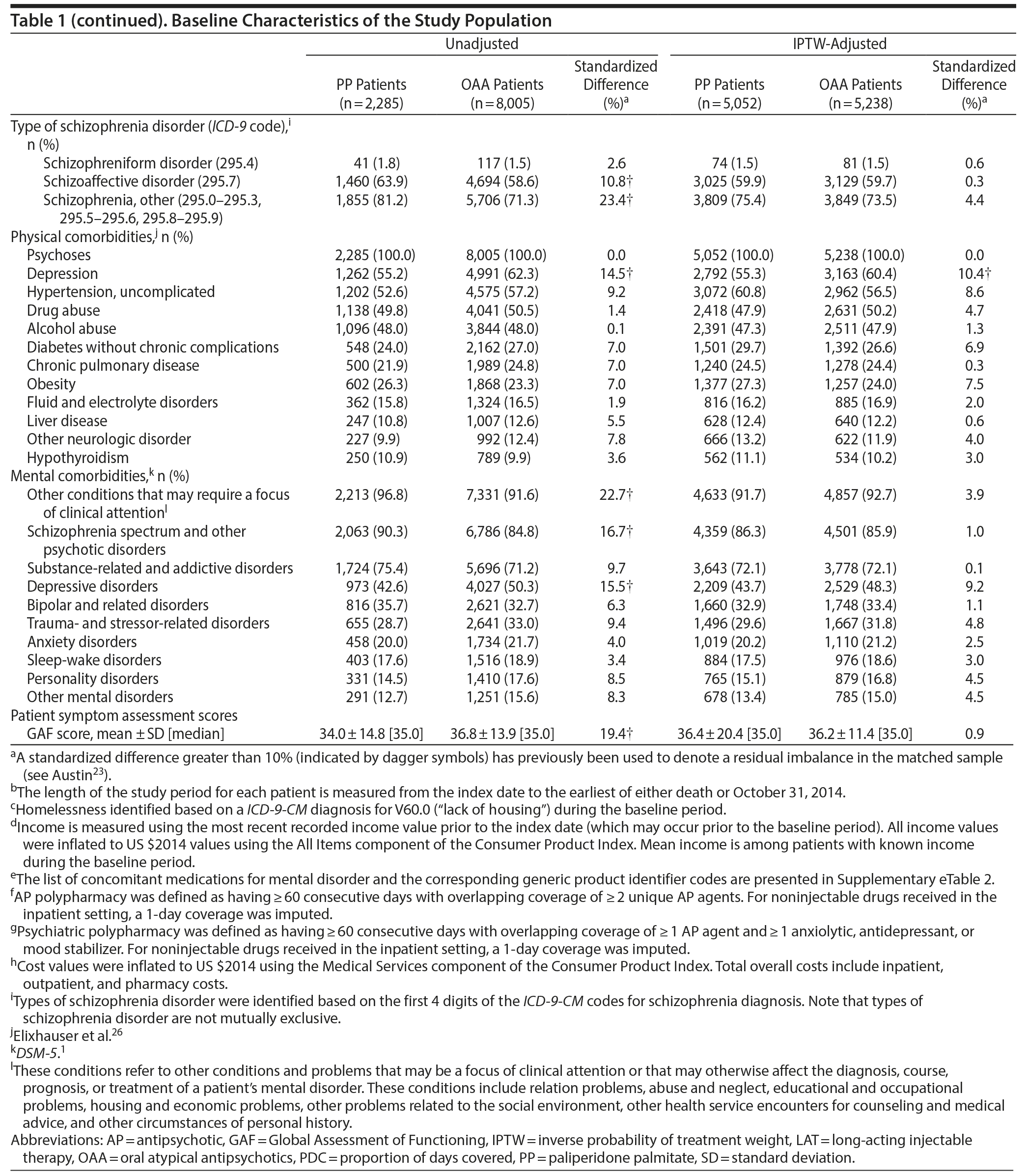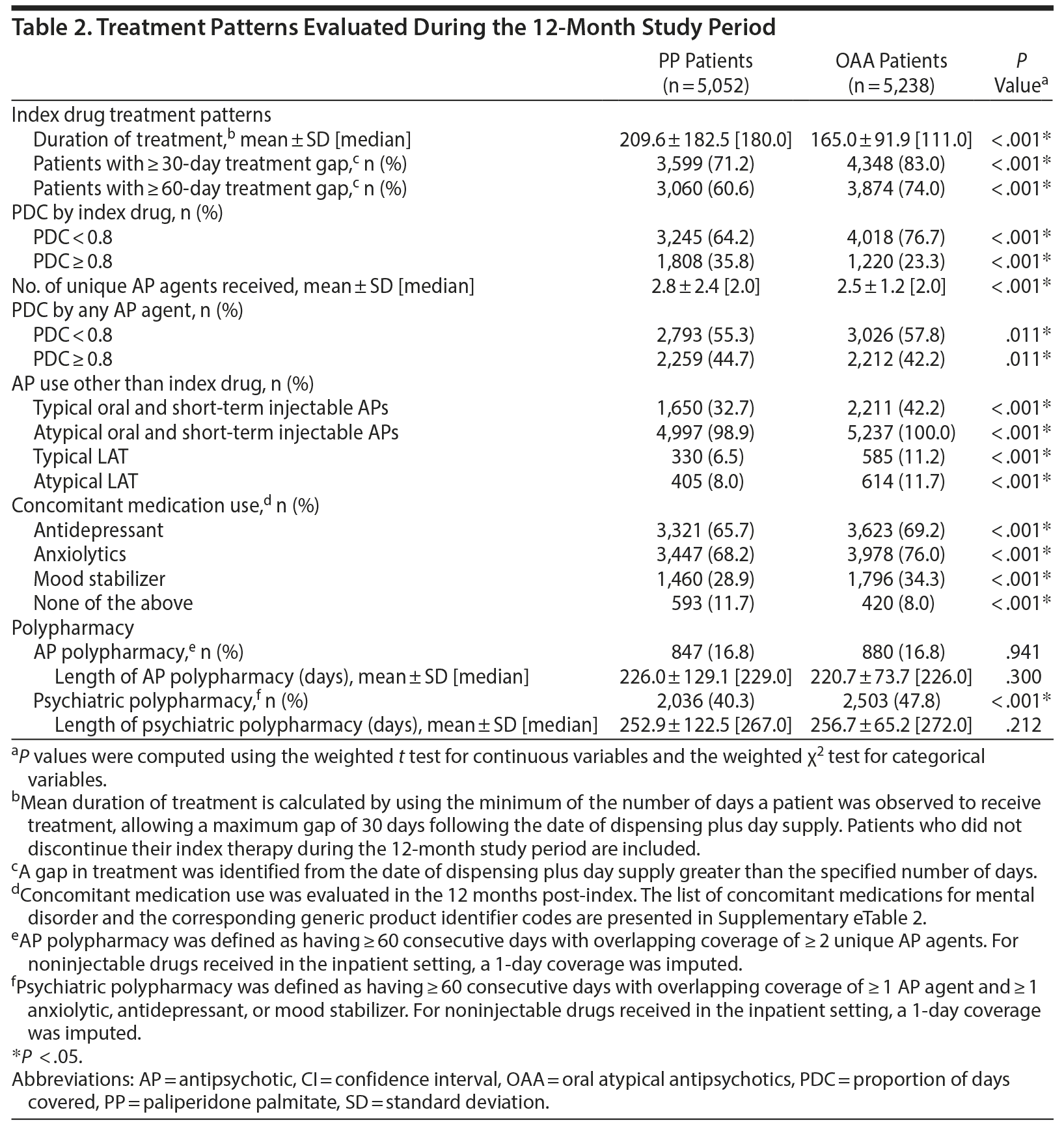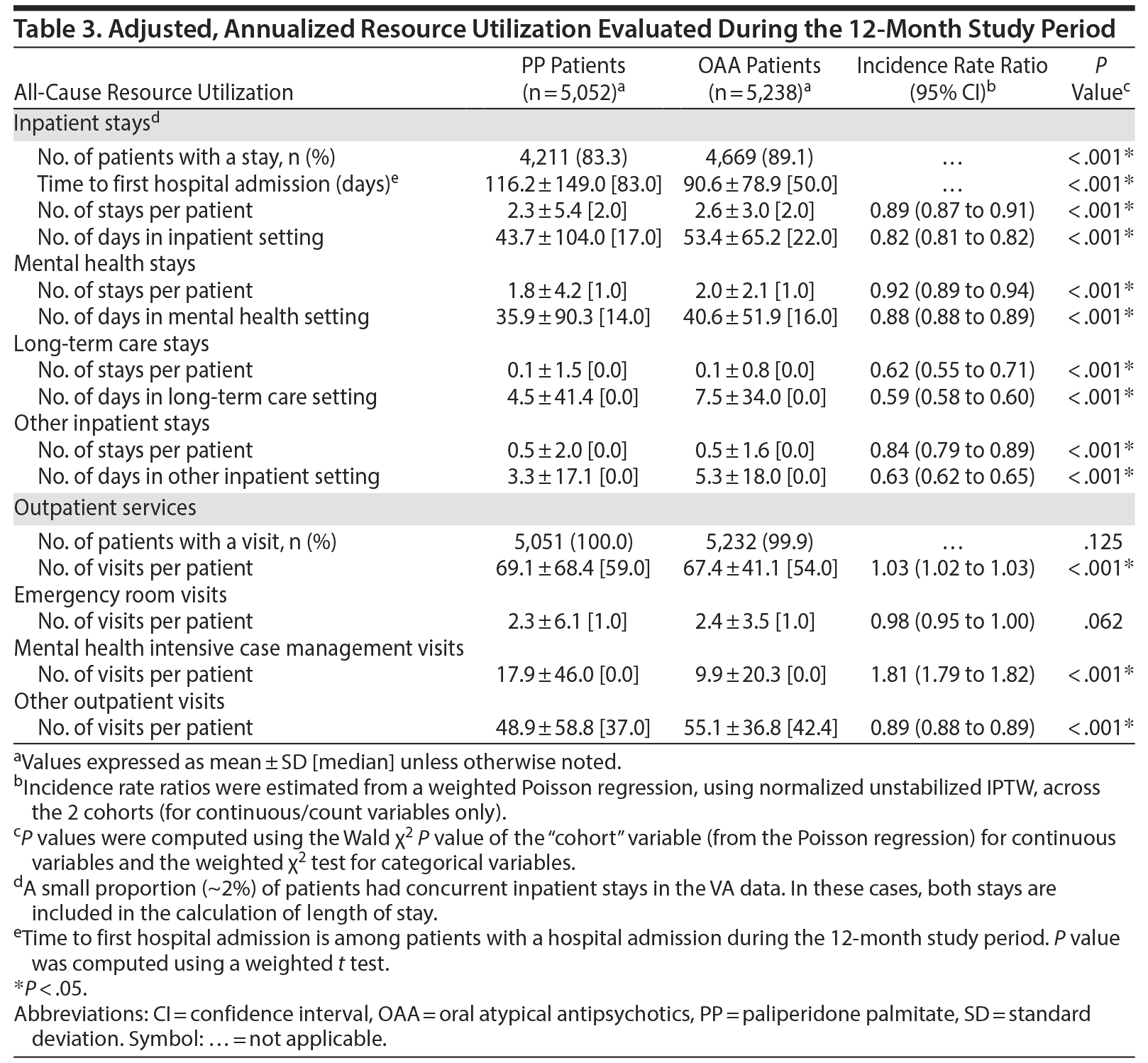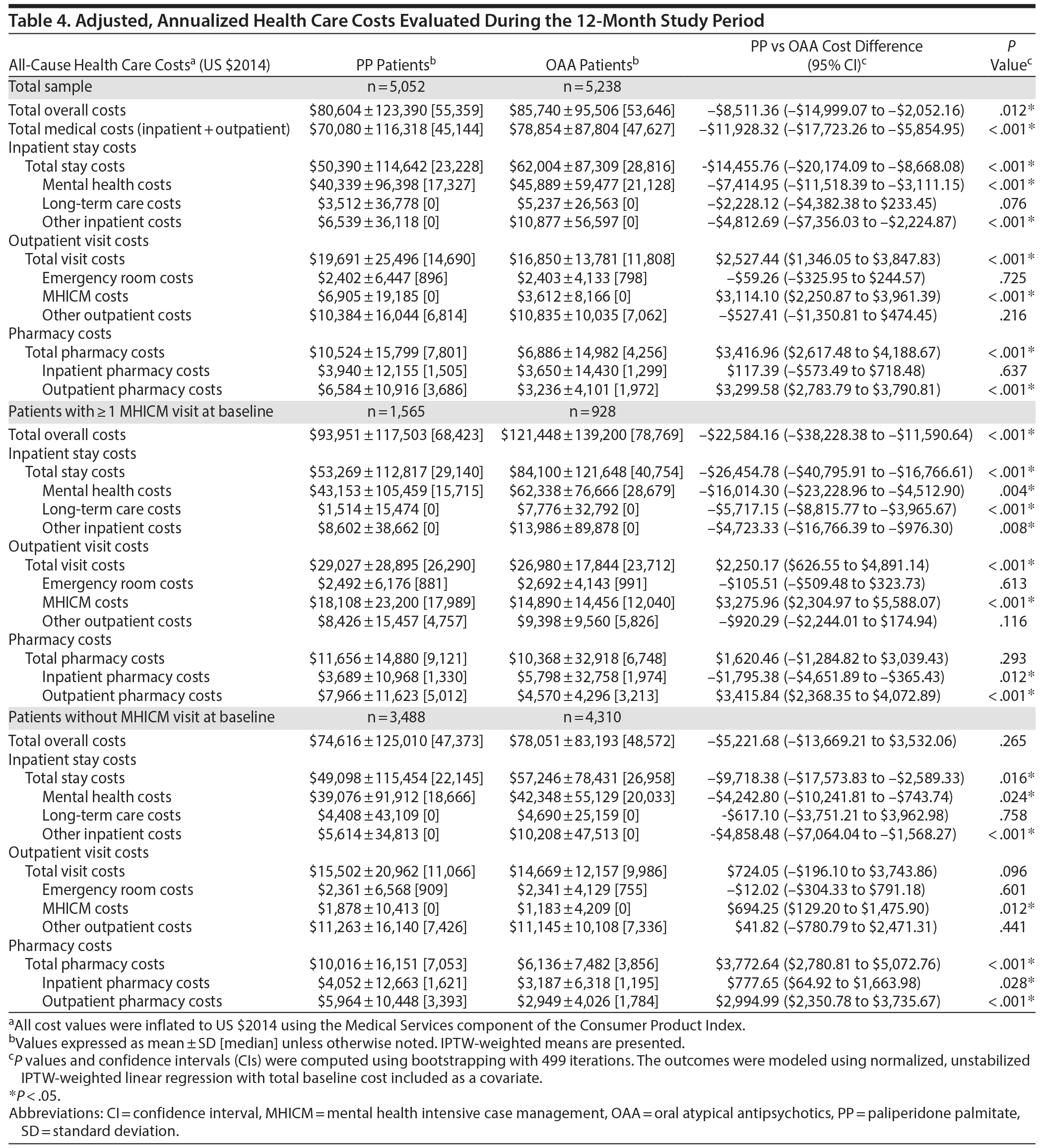Objective: To compare health care resource utilization and costs in veterans with schizophrenia treated with paliperidone palmitate (PP) versus oral atypical antipsychotics (OAAs).
Methods: A retrospective longitudinal study was conducted using electronic health record data from the Veterans Health Administration. Veterans with schizophrenia (identified using ICD-9-CM 295.x) initiating PP or OAAs between January 2010 and October 2014, with ≥ 12 months of benefits enrollment prior to treatment initiation and ≥ 6 months of enrollment after treatment initiation, and with ≥ 1 Global Assessment of Functioning measurement at baseline were included. Inverse probability of treatment weighted regression models were used to estimate incidence rate ratios (IRRs) and cost differences (CDs) for the impact of PP versus OAAs on health care resource utilization and costs.
Results: Among 10,290 eligible veterans, 2,285 and 8,005 were initiated on PP and OAAs, respectively. After adjustment, PP was associated with less frequent all-cause inpatient hospitalizations (IRR = 0.89, P < .001) and more frequent mental health intensive case management visits (IRR = 1.81, P < .001) compared to OAAs. PP treatment was associated with higher likelihood of increased income (odds ratio [OR] = 1.20, P = .027) and lower likelihood of homelessness (OR = 0.82, P < .001). While mean annual pharmacy and outpatient costs were higher among PP users (CD = $3,417 pharmacy, $2,527 outpatient, P < .001), mean annual inpatient costs were lower (CD = -$14,456, P < .001), resulting in average annual total health care (medical and pharmacy) cost savings associated with PP (CD = -$8,511, P = .012) relative to OAAs.
Conclusions: PP treatment was associated with significantly lower total health care costs attributable to reduced inpatient admissions compared to OAAs. Higher mental health intensive case management participation among PP users may have contributed to the differences observed.
This work may not be copied, distributed, displayed, published, reproduced, transmitted, modified, posted, sold, licensed, or used for commercial purposes. By downloading this file, you are agreeing to the publisher’s Terms & Conditions.
Impact of Paliperidone Palmitate Versus Oral Atypical Antipsychotics on Health Care Resource Use and Costs in Veterans With Schizophrenia

ABSTRACT
Objective: To compare health care resource utilization and costs in veterans with schizophrenia treated with paliperidone palmitate (PP) versus oral atypical antipsychotics (OAAs).
Methods: A retrospective longitudinal study was conducted using electronic health record data from the Veterans Health Administration. Veterans with schizophrenia (identified using ICD-9-CM 295.x) initiating PP or OAAs between January 2010 and October 2014, with ≥ 12 months of benefits enrollment prior to treatment initiation and ≥ 6 months of enrollment after treatment initiation, and with ≥ 1 Global Assessment of Functioning measurement at baseline were included. Inverse probability of treatment weighted regression models were used to estimate incidence rate ratios (IRRs) and cost differences (CDs) for the impact of PP versus OAAs on health care resource utilization and costs.
Results: Among 10,290 eligible veterans, 2,285 and 8,005 were initiated on PP and OAAs, respectively. After adjustment, PP was associated with less frequent all-cause inpatient hospitalizations (IRR = 0.89, P < .001) and more frequent mental health intensive case management visits (IRR = 1.81, P < .001) compared to OAAs. PP treatment was associated with higher likelihood of increased income (odds ratio [OR] = 1.20, P = .027) and lower likelihood of homelessness (OR = 0.82, P < .001). While mean annual pharmacy and outpatient costs were higher among PP users (CD = $3,417 pharmacy, $2,527 outpatient, P < .001), mean annual inpatient costs were lower (CD = -$14,456, P < .001), resulting in average annual total health care (medical and pharmacy) cost savings associated with PP (CD = -$8,511, P = .012) relative to OAAs.
Conclusions: PP treatment was associated with significantly lower total health care costs attributable to reduced inpatient admissions compared to OAAs. Higher mental health intensive case management participation among PP users may have contributed to the differences observed.
J Clin Psychiatry 2016;77(10):e1332-e1341
dx.doi.org/10.4088/JCP.16m10745
© Copyright 2016 Physicians Postgraduate Press, Inc.
aVA Medical Center, White River Junction, Vermont
bAnalysis Group, Inc, Boston, Massachusetts
cJanssen Scientific Affairs, LLC, Titusville, New Jersey
*Corresponding author: Erik Muser, PharmD, MPH, Janssen Scientific Affairs, LLC, 1125 Trenton-Harbourton Rd, Titusville, NJ 08560 ([email protected]).
Schizophrenia is a chronic mental illness that limits patients’ capacity for self-care, employment, and maintaining personal relationships.1 A systematic review estimated the incidence of schizophrenia to be about 15.2 per 100,000 persons in the United States, with an annual cost of approximately $30,000 per patient.2
As the largest integrated health care system in the United States, the Veterans Health Administration (VHA) cares for more than 6.9 million veterans annually, providing integrated and comprehensive services including primary, specialty, and inpatient care, rehabilitation services, long-term and home care, and other services to US military veterans.3 The number of veterans dealing with mental health issues has increased over time, and veterans with schizophrenia occupy more hospital beds than veterans with any other illness.4-6
When treating schizophrenia with oral antipsychotics, nonadherence often undermines the effectiveness of pharmacotherapy.7 Long-acting injectable antipsychotic therapies (LATs) are administered less frequently, thus providing extended medication coverage, which may improve adherence.8 Among injectable antipsychotics, paliperidone palmitate (PP) is an atypical LAT dosed monthly and approved by the US Food and Drug Administration (FDA) in 2009 for acute and maintenance treatment of schizophrenia. PP has demonstrated effectiveness for treating schizophrenia, though the drug cost is greater than that of oral atypical antipsychotics (OAAs).9-11 While some meta-analyses of randomized controlled trials (RCTs) comparing LATs to oral antipsychotics found no significant difference in clinical outcomes of patients receiving either treatment, the controlled environment of RCTs may not accurately reflect routine practice and real-world outcomes among schizophrenia patients.12,13 For instance, RCTs may enroll patients who are more likely to be adherent to their prescribed treatment regimens or have less severe disease.13 Requiring regular follow-up in RCTs may also increase adherence to prescribed regimens.
The objective of this study was to compare treatment patterns, health care resource utilization (HRU), and economic outcomes in US veterans treated with PP versus OAAs.
METHODS
Study Design and Patient Selection
A retrospective longitudinal cohort study was conducted using electronic medical record data from the VHA. The VHA Corporate Data Warehouse is an integrated and unified medical record system that contains data from all outpatient visits, hospital stays, treatments, prescriptions, laboratory results, billing, benefits information, demographics, socioeconomic information, and estimated costs of hospital stays and health care encounters.
The study design scheme is presented in Supplementary eFigure 1. Since PP was approved by the FDA on July 21, 2009, the study observation period began on January 1, 2010, to allow for uptake of the drug. The study population included veterans 18 years or older who had at least 2 schizophrenia diagnoses (ICD-9-CM code 295.x) during the observation period (at least 1 of which occurred during the baseline period) and at least 2 dispensings of PP or OAA within 90 days between January 1, 2010, and October 31, 2014, the first of which defined the index date. Patients were also required to be enrolled with VA benefits at least 12 months before (ie, baseline) and 6 months after the index date, have at least 1 Global Assessment of Functioning (GAF)14,15 measurement during baseline, and show evidence of at least 1 health care-related activity at least 6 months prior to the end of observation or a record of death. Patients receiving OAA were not allowed to have evidence of PP during the follow-up period but were still included in the study if they used other LATs during this period. Health care resource utilization and cost outcomes were assessed during the 12-month post-index period and annualized to 12 months for patients with less than 12 months of follow-up data.

- Few real-world observational studies have compared health care cost and resource use outcomes associated with paliperidone palmitate and oral atypical antipsychotics.
- Although higher mental health intensive case management participation among patients treated with paliperidone palmitate may be a contributing factor, treatment with this medication was associated with significantly lower total health care costs attributable to fewer hospitalizations compared to oral atypical antipsychotics.
Treatment, Outcomes, and Covariates
PP and OAAs were identified using NDC codes from inpatient and outpatient pharmacy and procedure records. The 9 OAAs included in the study were aripiprazole, asenapine maleate, iloperidone, lurasidone, olanzapine, quetiapine fumarate, risperidone, ziprasidone, and oral paliperidone.
Demographic, economic, and clinical characteristics were assessed during the 12-month pre-index baseline period including age, gender, race, region, marital status, homelessness, income, time since the availability of PP, Quan Charlson Comorbidity Index (CCI) score,16-18 previous treatment with antipsychotics, concomitant medications, HRU, health care costs, physical comorbidities, mental health comorbidities, and GAF score. Income values were based on means-testing data, which is conducted periodically to determine whether veterans are eligible for care at no or reduced out-of-pocket costs due to lower incomes. Information about veterans’ source of income was not available.
The outcomes of interest were treatment patterns, HRU, and health care costs. Treatment patterns assessed included days of persistence, proportion of patients with a gap in treatment from the date of dispensing plus days’ supply greater than 30 or 60 days, proportion of days covered (PDC), antipsychotic use (other than the index drug), and concomitant medication use. Persistence was defined conservatively using the minimum number of days a patient was observed to receive treatment, allowing a maximum gap of 30 days following the date of dispensing plus days’ supply. Proportion of days covered is defined as the proportion of days during the measurement period “covered” by prescription dispensings for the same medication. Antipsychotic polypharmacy was defined as having at least 60 consecutive days with overlapping coverage of at least 2 unique antipsychotic agents. Psychiatric polypharmacy was defined as having at least 60 consecutive days with overlapping coverage of at least 1 antipsychotic agent and at least 1 anxiolytic, antidepressant, or mood stabilizer. All-cause HRU and health care cost outcomes were annualized, assessed, and reported overall (ie, medical and pharmacy) and by type of services. Cost values were inflated to US $2014 using the Medical Services component of the Consumer Product Index.19 VHA Decision Support System data were used to evaluate costs.
Statistical Analysis
Inverse probability of treatment weighting. Inverse probability of treatment weighting was used to adjust for baseline differences between PP and OAA patients. Inverse probability of treatment weights (IPTWs) are defined as the inverse of the conditional probability of receiving a patient’s own treatment.20 Applying the IPTW creates a pseudopopulation in which the distribution of baseline confounders used to create the weights is balanced between cohorts.20,21
IPTWs were calculated for each patient in the PP and OAA cohorts. The propensity score (PS) was calculated using a pooled logistic regression model adjusting for the following baseline variables: index year, age, gender, race, region, marital status, homelessness, income, number of mental health diagnoses, CCI, antipsychotic use, concomitant medication use, schizophrenia diagnoses, mental and physical comorbidities with greater than 10% prevalence in baseline, GAF score, and the number and cost of inpatient and outpatient visits. IPTWs were then constructed as 1/PS for the PP cohort and 1/(1 – PS) for the OAA cohort. Normalized IPTWs were calculated by dividing each IPTW by the overall mean IPTW, and were examined for extreme values.22
Descriptive analyses. Unadjusted and IPTW-weighted baseline patient characteristics, treatment patterns during the observation period, and HRU following a mental health inpatient visit were summarized and compared between the PP and OAA cohorts using χ2 tests for categorical variables and Wilcoxon nonparametric tests for continuous variables. Imbalances in unadjusted and adjusted baseline covariates between the PP and OAA cohorts were assessed using standardized differences (std diff), with a threshold of > 10% indicating an imbalance.23
Regression models. IPTW-weighted linear and Poisson regression models were used to estimate the mean cost difference (CD) and incidence rate ratios (IRRs) for the impact of PP versus OAA on health care costs and HRU. The weighted models included a binary indicator for the index treatment variable; linear regression models for cost outcomes also included an adjustment covariate for total baseline costs to account for residual confounding. A nonparametric bootstrap procedure was used to calculate confidence intervals and P values based on 499 resamples of the dataset for health care cost outcomes to account for nonnormality. No adjustment was made for multiplicity. All analyses were conducted in SAS version 9.4 (SAS Institute, Cary, NC).
Sensitivity analysis. A sensitivity analysis was conducted to assess whether mental health intensive case management (MHICM, a VA program similar to assertive community treatment24 consisting of a multidisciplinary team of professionals using a client-centered, community-based approach to assist veterans with mental illness to live independently in the community) participation25 modified the association between treatment and outcomes. All statistical analyses were repeated in subgroups stratified by MHICM participation at baseline.
In addition, weighted logistic regression models were used to assess the impact of PP versus OAA on an increase in income (a binary variable based on whether a veteran’s income increased from baseline) and homelessness during the 12-month study period. Odds ratios, 95% confidence intervals, and P values were reported.
RESULTS
A total of 2,285 PP patients and 8,005 OAA patients were included in this study (Figure 1). Applying IPTW (weight range of 0.51-42.3, mean = 1.0, standard deviation = 1.67) to these treatment cohorts created a pseudopopulation of 5,052 PP patients and 5,238 OAA patients.
Baseline Demographic and Clinical Characteristics
Unadjusted and IPTW-adjusted baseline characteristics of the study population are reported in Table 1. Before adjustment, on average, PP patients were younger than OAA patients (mean age of 50.2 vs 53.7 years, std diff = 27.2%). The proportions of male OAA and PP patients appeared similar, though PP patients were more likely to be single and homeless compared to OAA patients (single: 46.8% vs 39.3%, std diff = 15.2%; homeless: 34.0% vs 29.0%, std diff = 10.6%). After applying IPTW, standardized differences greater than 10% were observed for only a few covariates, suggesting that the distribution of baseline confounders between the PP and OAA cohorts were balanced. Notably, PP patients were more likely to have received a greater number of unique antipsychotic agents (2.4 vs 1.3, std diff = 57.0%) than patients treated with OAAs. PP patients were also more likely to have used atypical oral and short-term injectable antipsychotics (87.6% vs 58.0%, std diff = 70.6%) and atypical LATs (33.5% vs 6.4%, std diff = 71.9%) than OAA patients.
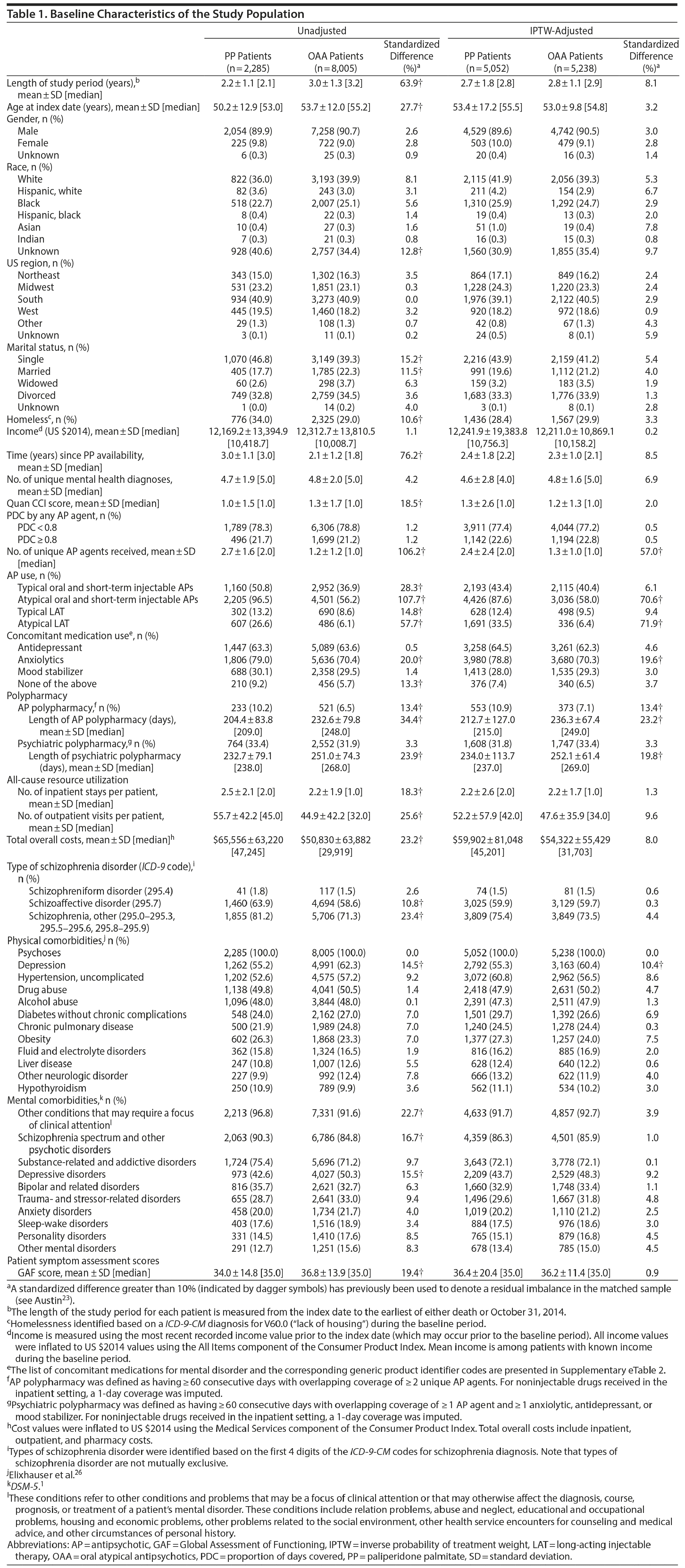
Treatment Patterns During Follow-Up
Treatment patterns evaluated during the annualized 12-month study period (after PP or OAA initiation) are presented in Table 2. Compared to OAA patients, patients treated with PP were persistent for a longer mean duration of time (209.6 days vs 165.0 days, P < .001) and a lower proportion of PP patients had a treatment gap of at least 30 days or at least 60 days (71.2% vs 83.0%, P < .001 and 60.6% vs 74.0%, P < .001). A higher proportion of PP patients had PDC ≥ 0.8 for their index drug (35.8% vs 23.3%, P < .001) compared to their OAA counterparts. In addition, a lower proportion of PP patients had psychiatric polypharmacy during the observation period compared to OAA patients (40.3% vs 47.8%, P < .001).
Association Between Treatment and HRU
As shown in Table 3, treatment with PP was associated with a lower rate of inpatient stays (IRR = 0.89, P < .001) and days in an inpatient setting (IRR = 0.82, P < .001) compared to treatment with OAAs. PP was also associated with a 3% increase in the incidence rate of outpatient visits per patient (IRR = 1.03, P < .001). This was driven primarily by the fact that PP patients had more frequent MHICM visits (IRR = 1.81, P < .001).
Among patients with a mental health inpatient stay, PP patients were less likely to be rehospitalized within 30 days of discharge compared to OAA patients (26.6% vs 29.1%, P = .010). HRU following a mental health inpatient visit is presented in Supplementary eTable 1.
Association Between Treatment and Health Care Costs
Adjusted, annualized mean health care costs evaluated during the 12-month study period and adjusted mean cost differences between treatment cohorts are presented in Table 4. Compared to treatment with OAAs, treatment with PP was associated with a mean total all-cause health care (medical and pharmacy) cost difference of -$8,511.36 (P = .012). Though PP treatment was associated with greater total outpatient visit costs ($2,527.44, P < .001) and higher pharmacy costs ($3,416.96, P < .001), this was offset by lower total inpatient stay costs (-$14,455.76, P < .001) resulting in total overall cost savings associated with PP relative to OAAs.
In addition, patients treated with PP were 20% more likely to experience an increase in income (OR = 1.20, P = .027) and 18% less likely to be homeless (OR = 0.82, P < .001) during the 12-month study period compared to patients treated with OAAs (Supplementary eFigure 2). With respect to GAF, patients treated with PP were more likely to experience an improvement in GAF score of at least 10 points (OR = 1.15, P = .055).
Results From Sensitivity Analysis Stratified by MHICM Participation at Baseline
With respect to HRU, the benefits of PP persisted in patients who participated in MHICM at baseline and those who did not, though the magnitudes of association were greater among patients with MHICM visits compared to patients without MHICM visits at baseline. Patients without MHICM visits at baseline treated with PP had fewer inpatient stays (IRR = 0.94, P < .001), mental health stays (IRR = 0.94, P < .001), and long-term care stays (IRR = 0.85, P = .040) per patient compared to OAA patients. However, PP patients had a greater number of MHICM visits (IRR = 1.52, P < .001). Similar results were seen in patients with MHICM visits at baseline.
As shown in Table 4, the difference in mean total (medical and pharmacy) health care costs between PP and OAA patients was not statistically significant (-$5,221.68, P = .265) among non-MHICM patients. While significant total health care cost savings associated with PP are not observed among patients who are not enrolled in MHICM during the baseline period, total health care costs were similar between the PP and OAA cohorts, with significant total inpatient stay cost savings (-$9,718.38, P = .016) fully offsetting higher total pharmacy costs ($3,772.64, P < .001) in PP patients relative to OAA patients. Among patients with MHICM visits at baseline, however, PP patients had significantly lower total all-cause health care costs (-$22,584.16, P < .001) compared to OAA patients. Thus, lower total health care costs associated with PP are apparent in patients with MHICM visits at baseline, but the evidence for total health care cost savings is not as definitive for patients who are not enrolled in MHICM during the baseline period.
DISCUSSION
This study found that PP was associated with less frequent all-cause inpatient hospitalizations, more frequent MHICM visits, and improved socioeconomic status during the annualized 12-month follow-up period compared to OAAs. While mean annual pharmacy and outpatient costs were higher among PP users, mean annual inpatient costs were lower, resulting in significant mean annual total cost savings associated with PP relative to OAAs. This is the largest study to examine health care costs and HRU associated with PP use among veterans to date. Given the difficulty of designing generalizable randomized trials of LATs in which improved adherence and persistence is the hypothesized mechanism of incremental benefit relative to oral antipsychotics, observational data are useful to demonstrate the benefit associated with PP and for informing clinical practice.
While PS matching is often used in studies to adjust for differences in baseline confounders, it may result in smaller sample size when appropriate matches between treated and control patients are not found, thus decreasing power. Furthermore, incomplete matching may make it difficult to describe the population of patients for whom matched results apply. The IPTW method applied in this study allows for the preservation of the total sample size while adjusting for baseline confounding, making the results more generalizable to the total population. While some residual confounding may remain after weighting by IPTW, this would result in more conservative estimates of association as the PP cohort has a higher proportion of patients with polypharmacy and a greater number of unique AP agents received at baseline (after weighting), suggesting that severity of disease is slightly greater for the PP cohort than the OAA cohort.
Results from this study are consistent with previous research.27-30 For instance, Xiao et al27 found that PP patients had lower medical costs attributable to reduced inpatient and long-term care admissions compared to OAA patients. These lower medical costs offset the higher pharmacy expense for PP-treated patients, resulting in comparable total overall costs and suggesting enhanced clinical management of schizophrenia. Similarly, Baser et al28 found that PP treatment was associated with lower mean inpatient costs, lower hospitalization rates, and a shorter length of stay in inpatient days versus OAA treatment.
In our study, patients treated with PP had higher persistence and lower proportions of patients with 30 or 60 day gaps in treatment than patients treated with OAAs. This may explain the differences observed since improved medication coverage is especially important for schizophrenia patients who are more likely to experience relapse or rehospitalization when they discontinue therapy. LATs like PP provide longer and more persistent medication coverage, and allow clinicians to confirm adherence as the medication is administered via injection by a health care provider. For this reason, it was expected that PP treatment might be associated with greater frequency of outpatient visits and higher outpatient costs compared to treatment with OAAs. The increased frequency of outpatient visits, and especially MHICM visits, also indicates that PP patients may be more engaged in their health and experience greater continuity of care. This is a positive outcome among schizophrenia patients, who often fail to follow-up with health care providers and skip health care visits.
While the incremental increase is small, the greater proportion of patients experiencing an increase in income and the lower proportion of patients experiencing homelessness during the 12 months following initiation of treatment with PP is promising. Treating schizophrenia patients with PP may give them better opportunities for future employment and positively affect patients’ socioeconomic status, which is important as patients with schizophrenia often find themselves in more difficult economic circumstances than the general population.
The general conclusions of the study held in the sensitivity analysis examining subgroups of patients stratified by MHICM participation status at baseline. Statistically significant savings in total health care costs associated with PP were observed only in patients with MHICM visits at baseline, though statistically significant reductions in total inpatient stay costs associated with PP were also observed for patients who were not enrolled in MHICM at baseline. Thus, MHICM participation may be modifying the effect of or interacting with PP (compared to OAA) and contributing to the lower health care costs observed, especially since previous research has demonstrated that MHICM is a cost effective treatment among veterans.31 In addition, post-baseline MHICM participation may have also impacted the results of this study as a greater number of MHICM visits were observed among PP patients in the post-baseline period for both baseline MHICM stratified groups (ie, patients participating in MHICM visits at baseline and patients not participating in MHICM visits at baseline). While a time-varying analysis of post-index MHICM participation was not part of the current study, this is an important topic that merits exploration in future research.
Limitations
This study has several limitations. For instance, all patients were required to have a GAF score recorded during baseline, which reduced our sample size. Furthermore, the majority of GAF scores captured were assessed during inpatient hospital stays, making the GAF score inclusion requirement essentially a proxy for inpatient hospitalization. Though this was unexpected when inclusion criteria were developed, imposing this criterion may have helped ensure similar acuity of illness and disease severity in OAA and PP patients. Patients with more severe disease are more likely to be hospitalized with schizophrenia and would be in greater need of interventions to improve symptoms. In addition, including this criterion was important to ensure all patients had a baseline functioning score that could be adjusted for by including the variable in the model used to construct IPTW. Thus, while the GAF score requirement may be a limitation, it also may have strengthened the analysis.
Also, almost all patients in the PP cohort used atypical oral and short-term injectable antipsychotics during the follow-up period. This may be due to the fact that OAAs are used to treat a number of mental health comorbidities that co-occur with schizophrenia, such as depression and bipolar disorder as well as insomnia, or it may be that these agents are adjunctive support for management of schizophrenia symptoms. In addition, this study does not consider whether patients switch treatment during the observation period. Rather, the analysis took an “intention-to-treat” approach that likely resulted in conservative estimates of association as many patients in the OAA cohort had LAT dispensings during the study period. Sixty percent of PP users and 74% of AP users had a treatment gap of at least 60 days, indicating that there may be partial or full overlap of medications when patients are being switched to a new antipsychotic, as evidenced by the 17% of PP and OAA patients with antipsychotic polypharmacy.
Findings from this study may be limited in their generalizability to the total US population as the study sample was specific to veterans obtaining health care through the VHA system, who may have very different characteristics and comorbidities compared to the general population. Specifically, less than 10% of our study sample consisted of women. Also, as with all retrospective observational studies, the results may be subject to selection bias and residual confounding by unmeasured confounders, though a large number of covariates were included when building the IPTW. While outcomes such as relapse and adverse events associated with PP or OAA treatment may be of interest and warranted in a future study, they were not assessed in the current study.
CONCLUSIONS
With its once monthly injection, PP was associated with improvements in adherence, reduced hospitalization rates, and improved socioeconomic standing among veterans with schizophrenia. Although more frequent MHICM visits among PP patients during the observation period may have contributed to differences observed relative to OAA patients, the greater pharmacy cost observed among PP patients was more than offset by reductions in inpatient costs resulting in average annual total health care (medical and pharmacy) cost savings of more than $8,000 per patient. Thus, PP appears to be a promising treatment option for schizophrenia with the potential to reduce hospitalizations as well as health care costs compared to OAA therapy.
Submitted: February 12, 2016; accepted June 10, 2016.
Online first: August 30, 2016.
Drug names: aripiprazole (Abilify and others), asenapine (Saphris), iloperidone (Fanapt), lurasidone (Latuda), olanzapine (Zyprexa and others), paliperidone oral (Invega and others), paliperidone palmitate (Invega Sustenna), quetiapine (Seroquel and others), risperidone (Risperdal and others), ziprasidone (Geodon and others).
Potential conflicts of interest: Drs Muser and Fu are employees of Janssen Scientific Affairs, LLC. Drs Duh and DerSarkissian, Mss Faust and Bhak, and Messrs Kageleiry and Lefebvre are employees of Analysis Group, Inc which receives research grants from Janssen Scientific Affairs, LLC. Drs Young-Xu and Shiner declare no conflicts of interest.
Funding/support: This study was supported by Janssen Scientific Affairs, LLC, Titusville, NJ. Dr Shiner is supported by a VA Health Services Research and Development Career Development Award (CDA11-263).
Role of the sponsor: Employees from Janssen Scientific Affairs participated in designing the study, interpreting results, and drafting the manuscript.
Previous presentation: Poster presented at the Academy of Managed Care Pharmacy (AMCP) 2015 NEXUS Congress; October 26-29, 2015; Orlando, Florida.
Supplementary material: See accompanying pages.
REFERENCES
1. American Psychiatric Association. Schizophrenia. Diagnostic and Statistical Manual for Mental Disorders. Fifth Edition. Washington, DC: American Psychiatric Association; 2013:99-105.
2. McGrath J, Saha S, Chant D, et al. Schizophrenia: a concise overview of incidence, prevalence, and mortality. Epidemiol Rev. 2008;30(1):67-76. PubMed doi:10.1093/epirev/mxn001
3. United States Office of Management and Budget, Department of Veterans Affairs: Veterans Health Administration. The Budget for Fiscal Year 2016. Washington, DC: United States Government; 2015:1057-1066.
4. Kang HK, Hyams KC. Mental health care needs among recent war veterans. N Engl J Med. 2005;352(13):1289. PubMed doi:10.1056/NEJMp058024
5. Rosenheck RA, Fontana AF. Recent trends in VA treatment of post-traumatic stress disorder and other mental disorders. Health Aff (Millwood). 2007;26(6):1720-1727. PubMed doi:10.1377/hlthaff.26.6.1720
6. Hermes EDA, Rosenheck RA, Desai R, et al. Recent trends in the treatment of posttraumatic stress disorder and other mental disorders in the VHA. Psychiatr Serv. 2012;63(5):471-476. PubMed doi:10.1176/appi.ps.201100432
7. Haddad PM, Brain C, Scott J. Nonadherence with antipsychotic medication in schizophrenia: challenges and management strategies. Patient Relat Outcome Meas. 2014;5:43-62. PubMed doi:10.2147/PROM.S42735
8. Lang K, Meyers JL, Korn JR, et al. Medication adherence and hospitalization among patients with schizophrenia treated with antipsychotics. Psychiatr Serv. 2010;61(12):1239-1247. PubMed doi:10.1176/ps.2010.61.12.1239
9. Alphs L, Bossie CA, Sliwa JK, et al. Onset of efficacy with acute long-acting injectable paliperidone palmitate treatment in markedly to severely ill patients with schizophrenia: post hoc analysis of a randomized, double-blind clinical trial. Ann Gen Psychiatry. 2011;10(1):12. PubMed doi:10.1186/1744-859X-10-12
10. Mehnert A, Nicholl D, Pudas H, et al. Cost effectiveness of paliperidone palmitate versus risperidone long-acting injectable and olanzapine pamoate for the treatment of patients with schizophrenia in Sweden. J Med Econ. 2012;15(5):844-861. PubMed doi:10.3111/13696998.2012.681531
11. Bressington D, Stock J, Hulbert S, et al. A retrospective observational study of the effectiveness of paliperidone palmitate on acute inpatient hospitalization rates. Int Clin Psychopharmacol. 2015;30(4):230-236. PubMed doi:10.1097/YIC.0000000000000077
12. Kirson NY, Weiden PJ, Yermakov S, et al. Efficacy and effectiveness of depot versus oral antipsychotics in schizophrenia: synthesizing results across different research designs. J Clin Psychiatry. 2013;74(6):568-575. PubMed doi:10.4088/JCP.12r08167
13. Kishimoto T, Nitta M, Borenstein M, et al. Long-acting injectable versus oral antipsychotics in schizophrenia: a systematic review and meta-analysis of mirror-image studies. J Clin Psychiatry. 2013;74(10):957-965. PubMed doi:10.4088/JCP.13r08440
14. Aas IHM. Global Assessment of Functioning (GAF): properties and frontier of current knowledge. Ann Gen Psychiatry. 2010;9(1):20. PubMed doi:10.1186/1744-859X-9-20
15. Piersma HL, Boes JL. The GAF and psychiatric outcome: a descriptive report. Community Ment Health J. 1997;33(1):35-41. PubMed doi:10.1023/A:1022413110345
16. Quan H, Li B, Couris CM, et al. Updating and validating the Charlson comorbidity index and score for risk adjustment in hospital discharge abstracts using data from 6 countries. Am J Epidemiol. 2011;173(6):676-682. PubMed doi:10.1093/aje/kwq433
17. Charlson ME, Pompei P, Ales KL, et al. A new method of classifying prognostic comorbidity in longitudinal studies: development and validation. J Chronic Dis. 1987;40(5):373-383. PubMed doi:10.1016/0021-9681(87)90171-8
18. Quan H, Sundararajan V, Halfon P, et al. Coding algorithms for defining comorbidities in ICD-9-CM and ICD-10 administrative data. Med Care. 2005;43(11):1130-1139. PubMed doi:10.1097/01.mlr.0000182534.19832.83
19. Ford IK, Ginsburg DH. Medical Care in the Consumer Price Index. In: Cutler DM, Berndt ER, eds. Medical Care Output and Productivity. Chicago, IL: University of Chicago Press; 2001:203-220. doi:10.7208/chicago/9780226132303.003.0006
20. Robins JM, Hernán MA, Brumback B. Marginal structural models and causal inference in epidemiology. Epidemiology. 2000;11(5):550-560. PubMed doi:10.1097/00001648-200009000-00011
21. Hernán MA, Brumback B, Robins JM. Marginal structural models to estimate the causal effect of zidovudine on the survival of HIV-positive men. Epidemiology. 2000;11(5):561-570. PubMed doi:10.1097/00001648-200009000-00012
22. Hansen RA, Farley JF, Maciejewski ML, et al. Real-world utilization patterns and outcomes of colesevelam hcl in the ge electronic medical record. BMC Endocr Disord. 2013;13(1):24. PubMed doi:10.1186/1472-6823-13-24
23. Austin PC. Balance diagnostics for comparing the distribution of baseline covariates between treatment groups in propensity-score matched samples. Stat Med. 2009;28(25):3083-3107. PubMed doi:10.1002/sim.3697
24. Bond G, Drake R, Mueser K, et al. Assertive community treatment for people with severe mental illness. Dis Manag Health Outcomes. 2001;9(3):141-159. doi:10.2165/00115677-200109030-00003
25. Neale M, Rosenheck R, Castrodonatti J, et al. Mental Health Intensive Case Management (MHICM): The Tenth National Performance Monitoring Report: FY 2006. West Haven, CT. Northeast Program Evaluation Center; 2007.
26. Elixhauser A, Steiner C, Kruzikas D. US Agency for Healthcare Research and Quality. HCUP methods series report #2004-1. Comorbidity Software Documentation. p. 12-5. http://www.hcup-us.ahrq.gov/reports/ComorbiditySoftwareDocumentationFinal.pdf. Published February 6, 2004. Accessed 2013.
27. Xiao Y, Muser E, Lafeuille M-H, et al. Impact of paliperidone palmitate versus oral atypical antipsychotics on healthcare outcomes in schizophrenia patients. J Comp Eff Res. 2015;4(6):579-592. PubMed doi:10.2217/cer.15.34
28. Baser O, Xie L, Pesa J, et al. Healthcare utilization and costs of Veterans Health Administration patients with schizophrenia treated with paliperidone palmitate long-acting injection or oral atypical antipsychotics. J Med Econ. 2015;18(5):357-365. PubMed doi:10.3111/13696998.2014.1001514
29. Lafeuille M-H, Laliberté-Auger F, Lefebvre P, et al. Impact of atypical long-acting injectable versus oral antipsychotics on rehospitalization rates and emergency room visits among relapsed schizophrenia patients: a retrospective database analysis. BMC Psychiatry. 2013;13(1):221. PubMed doi:10.1186/1471-244X-13-221
30. Morrato EH, Parks J, Campagna EJ, et al. Comparative effectiveness of injectable paliperidone palmitate versus oral atypical antipsychotics: early postmarketing evidence. J Comp Eff Res. 2015;4(2):89-99. PubMed doi:10.2217/cer.14.50
31. Rosenheck RA, Neale MS. Cost-effectiveness of intensive psychiatric community care for high users of inpatient services. Arch Gen Psychiatry. 1998;55(5):459-466. PubMed doi:10.1001/archpsyc.55.5.459
This PDF is free for all visitors!
